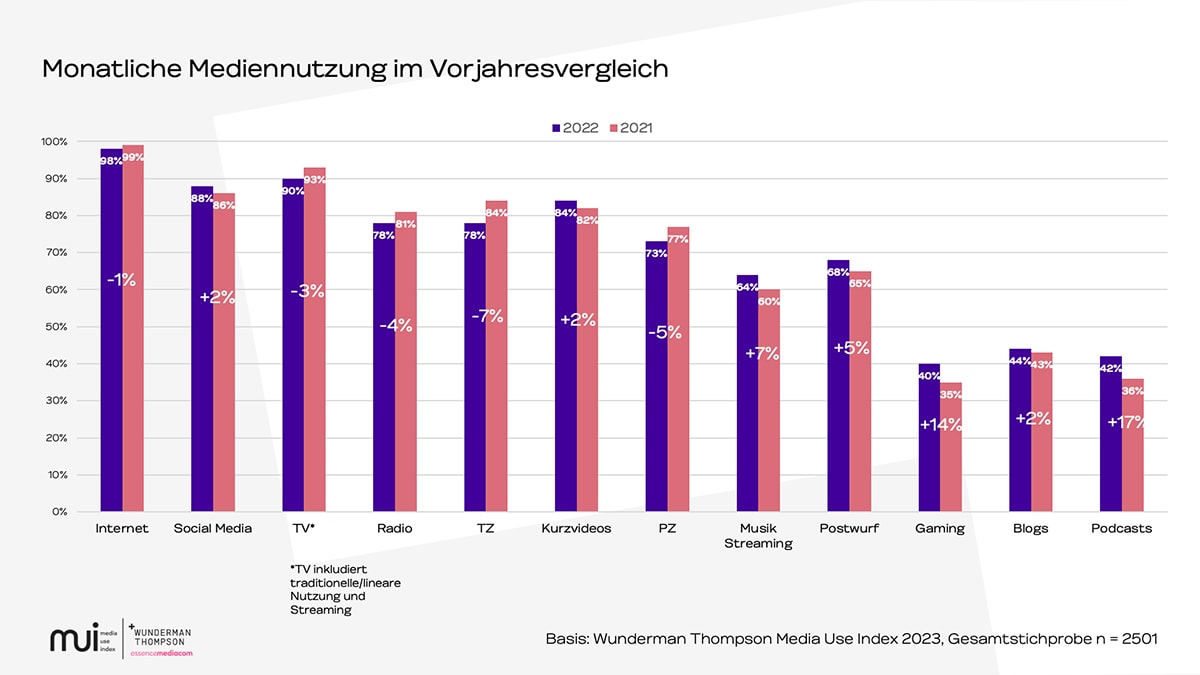Media Use Index: Stronger focus on digital
The "Media Use Index 2023" by Wunderman Thompson examines the current media use and information behavior of the Swiss population and highlights developments, the latest trends and potential.
"The digitization of our everyday lives is advancing relentlessly. Nowhere is this more evident than in media usage. Virtually all channels are now, at least in part, digital," says Peter Petermann, Head of Strategy at Wunderman Thompson. "We have been studying and documenting these changes with the Wunderman Thompson Media Use Index for 14 years now. We want to use it to help advertisers communicate better with their target audiences."
In this year's study, Wunderman Thompson adjusted the focus of the analysis: Less "classic" media and hardware, more digital channels and content. By means of a representative online survey, in cooperation with sister agency EssenceMediacom, around 2,500 people between the ages of 16 and 69 were questioned.
The study provides insights into the media usage and information behavior of the Swiss population, particularly on the topics of streaming, gaming, social media, influencers and e-commerce. A separate deep dive on the trend topic of "social commerce" also shows how social media is increasingly establishing itself as an additional sales channel.
Media use in transition: from URL to IRL
While the last few years were characterized by increased media use - not least due to the influence of the Covid 19 pandemic - a change can be seen again for the first time: Compared to the previous year, almost all media surveyed are losing ground in daily use. The Swiss:in the meantime seem to prefer to spend their everyday life again IRL - "in real life" - rather than online. Particularly affected here are "classic" channels such as radio, daily newspapers and general-interest magazines. But TV and short videos are also watched less frequently.
But there are also clear winners in terms of usage intensity: gaming, podcasts and music streaming are rising in monthly usage. Social media can also still make slight gains and is just in second place in daily usage. The data used covers the entire year 2022.
Gaming becomes the new mainstream
What is particularly exciting is that gaming is establishing itself as a new mainstream: More than half of the Swiss population has already had contact with the topic, and the trend is increasing every year. The study shows that gaming is not only being actively pursued, but is increasingly becoming a spectator event, just like other sports and entertainment formats.
Role of social media is changing
For a long time, the definition of social media was characterized by exchange among users. The study now shows a change in usage: 42 percent of respondents active on social media use the platforms for entertainment. Only in second place, with 40 percent, is social media primarily used for contact with friends and families. Communicating and sharing one's own opinions is becoming less relevant. Social media is therefore developing away from a channel for social contacts and toward a news and entertainment channel.
Influence of Influencer:inside
"Influencers are now a serious channel for brands, not just as content creators, but along the entire funnel," explains Peter Petermann. "They accompany the customer journey all the way to the sale, because this is increasingly taking place online."
A total of 42 percent of Swiss people regularly follow various influencers, and in Gen Z the figure is as high as 75 percent. Influencers are perceived as more inspiring, entertaining and informative than the offerings of traditional media and advertising. For this reason, they are becoming advisors in the purchasing process for more and more Swiss people: for up to 30 percent of the total population, an influencer recommendation has a significant influence on the purchase decision. Among the youngest, up to 25 years of age, the figure is even higher.
The ongoing boom in e-commerce
98 percent of the Swiss population between the ages of 16 and 69 have already purchased products or services online, and there are virtually no age differences in e-commerce anymore. According to the study, the main driver of booming e-commerce is convenience: "Convenience" and "independence from opening hours" are named most frequently. Price only comes in fourth place in Switzerland.
Social commerce is becoming more and more popular
In a separate deep dive conducted in March 2023, this year's Media Use Index highlights the trending topic of "social commerce," digital shopping in the context of social media. The study shows that social media is increasingly establishing itself as an additional sales channel and that social commerce is therefore a perfectly acceptable form of shopping for around one third of respondents. According to Petermann, it will no longer be necessary to distinguish between "normal" shopping and e-commerce and social commerce.
"A large part of life is increasingly taking place on social media" says Giselle Vaugne, Co-CEO Wunderman Thompson. "This insight from this MUI study is essential for us. Brands that want to be relevant across all age groups in the future will have to face the challenge of advertising in a more fragmented and channel-specific way depending on the target audience."












